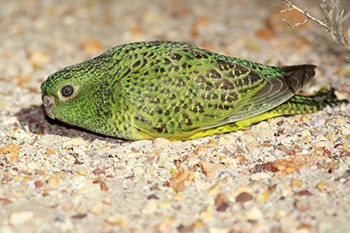Night parrot
Preserving the habitat of the mysterious night parrot
By preserving its habitat, controlling invasive predators and supporting ongoing research, we can help to protect the elusive night parrot in Queensland.

Fast facts
Common name: Night parrot
Scientific name: Pezoporus occidentalis
Family: Psittaculidae (parrots, lorikeets and rosellas)
Status: Endangered
Habitat: Remote, arid zones with dense, low vegetation such as spinifex
Species overview
The night parrot is a mysterious and elusive bird only found in Australia. This nocturnal bird is difficult to find, but gradually, we are learning more about it.
The night parrot is culturally significant to the Maiawali People and was used in traditional ceremonial practices. The Maiawali call it the Pullen Pullen bird, the name given to the nature reserve created to protect it.
For almost 80 years, scientists believed the bird was extinct, with the last night parrot specimen recorded in Western Australia in 1912. Then, in 1990, scientists found a night parrot carcass by chance near Boulia in western Queensland and another carcass was found in 2006 in the Diamantina National Park. The search for the rare bird resumed.
In 2013, scientists rediscovered live night parrots on a neighbouring property, Brighton Downs, in western Queensland—the exact location initially kept secret to protect the small population of between 10 and 20 birds.
Ecology and behaviour
While we are still gathering knowledge about the night parrot, we know this bird aids in seed dispersal, helping to maintain the health of its outback ecosystem.
The night parrot is mostly a ground-dwelling bird. It relies on old-growth, dense hummock-forming spinifex, thickets of lignum, or dense shrubby samphire for shelter and nesting.
Sound recordings confirm the night parrot emerges at night to forage and drink. While recent studies in western Queensland have found that night parrots are more sedentary than previously thought, scientists have recorded them travelling up to 41km in a single night.
Scientists have also found that the bird has asymmetrical ear openings, perhaps to compensate for its poor night vision.

Characteristics
The night parrot is:
- a medium-sized nocturnal bird
- camouflaged with distinctive yellow, green and black flecked colouring
- known to make a ‘ding-ding’ call like that of a bell miner (Manorina melanophrys), a short frog-like ‘grieet’ and other three and four-note calls.
Threats
Research is being undertaken on the key threats to night parrots, with the following threats currently suspected:
- Introduced predators, such as feral cats and European foxes
- Habitat loss and fragmentation
- Altered fire regimes.
What’s being done?
- In 2019, Queensland became the first state to legislate a new class of protected area, Special Wildlife Reserves, providing national park level protections to privately owned land. Queensland is currently the only Australian state to do this.
The Special Wildlife Reserve is the only way to fully protect private land from the threats of mining, timber harvesting and commercial grazing.
Special Wildlife Reserves protect exceptional natural values and resources, including unique ecosystems or species found nowhere else in the state, and culturally significant Country for First Nations People. - In 2020, Pullen Pullen became Queensland’s first Special Wildlife Reserve, protecting 56,000 hectares of land and a significant proportion of the night parrot’s known habitat in Queensland.
- In 2023, we re-commenced a targeted feral cat control program in the eastern half of Diamantina National Park to reduce impacts on night parrots and other threatened species, such as the greater bilby.
- While bushfires are uncommon in known night parrot habitats in southwestern Queensland, we are working on fire management strategies to prevent fire ignition, including managing the increased fire risk associated with buffel grass infestations. We continue to search for new night parrot populations in conservation areas acquired in western Queensland.
- Queensland’s national parks and protected areas play an important role in protecting threatened species. As part of the Queensland Protected Area Strategy 2020–2030, we’re acquiring more land to expand our protected area system and help conserve critical species habitat.
Who is helping?
- Bush Heritage Australia (BHA)
Since 2016, BHA has researched the night parrot at the Pullen Pullen Special Wildlife Reserve with collaborators, including The University of Queensland, resulting in several publications. In 2016, BHA also established Pullen Pullen and continues to manage the night parrot’s habitat with guidance from the Maiawali People. BHA conducts surveys to monitor the bird’s population and helps manage threats e.g. by conducting regular cat control activities. BHA is sharing its knowledge of this cryptic species, working with others across Australia to increase its chances of survival.
Since 2016, UQ researchers have conducted research at Pullen Pullen and elsewhere in western Queensland in collaboration with BHA and other partners.
In 2024, Conservation Partners received Queensland Government funding to find new populations of night parrots in Queensland.
CSIRO researchers have sequenced the first genome of the night parrot, expanding our knowledge of its biology and offering insights to help develop conservation strategies.
How you can help
- Make a donation to support Queensland threatened species protection and science and research-based initiatives.
- Find out more about how you can help support threatened species efforts.